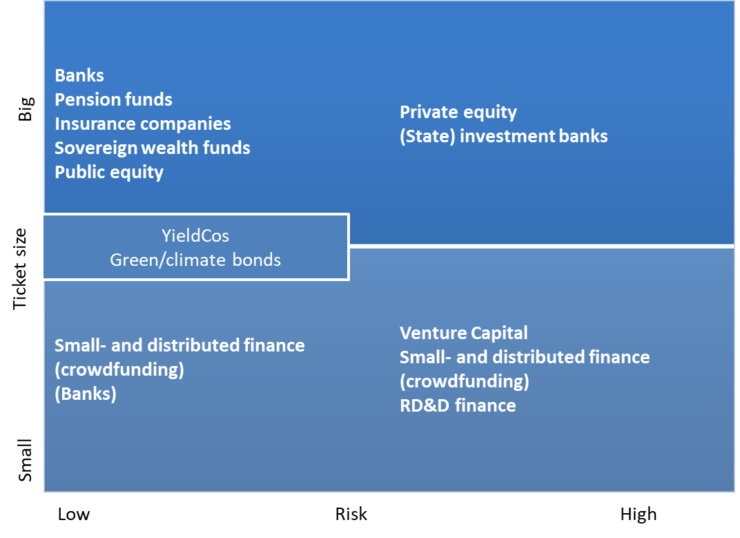We analyse supply and demand in major scenarios for the European energy transition until 2050. We then contrast it to the available sources of finance. The good news is that the private money is – in principle – available to finance the investments. The bad news however is that does not (yet) come in the forms and shapes that the European energy sector would need it. Changing the situation requires action from both the private and the public sector in the coming years[1].
We know how much we need
Many studies highlight the large amounts of investment into energy supply and demand that is required. An innovation-led sustainability transition requires both investments in invention and innovation as well as diffusion in a diversified financial system (Polzin et al., 2017). Our review reveals that under the individual investment and lending mandates the money is available. Many of the scenario-based analyses explicitly or implicitly neglect the sources of finance rather focusing on aggregate investment needs. For example McCollum et al. (2018, p. 591) state that ‘[…] given the nature of these models, we expressly address the question of ‘Where are the investment needs?’, not ‘Who pays for them?’’.
The money is available, but…
Our analysis further shows, on the one hand, that the volumes are available in the order of magnitude needed for a successful energy transition, especially when it comes to institutional investors. On the other hand, the numbers also reveal a qualitative mismatch. There is ample capacity to invest in scaling mature technologies, but there are shortages in (upstream) innovation finance, especially research, development and demonstration (RD&D) as well as venture capital and private equity. There the amounts are smaller, but the downstream impacts are not. There is no quantitative issue in freeing up these resources and a little will go a long way in solving the most urgent bottlenecks. However typically the types of finance suitable for funding experimentation are not so easy to mobilize in Europe’s highly institutionalized, bank based and regulated financial sector (Elert et al., 2019).
Who can do what?
It becomes apparent from our review that there is plenty of financing available especially in the later stages of technology lifecycle (see Figure 1) when the risks involved are comparably low. That means even within the current composition of equities, bond and alternative investments, institutional investors could engage in financing large-scale (low-risk) renewable energy projects (Röttgers et al., 2018). An effective reform of regulation and governance to allow these investors to engage more in unlisted long-term equity and debt will make ample funding available to scale the necessary technologies. These could be realised through intermediate channels such as green bonds or YieldCos but institutional investors also heavily engage in public equity markets another underutilized source (La Monaca et al., 2018).
In the earlier stages of the technology lifecycle (with considerable risks) the problem is more urgent. Here only hardly scalable solutions such as small and distributed finance and venture capital are available. These are also able to address significant early stage risks (see Figure 1). Larger ticket sizes and higher risks can only be handled by (state) investment banks and some private equity funds. State investment banks have the potential to scale-up their investments significantly. However, their main role would be in mobilising private finance through co-investments, signalling and education (Geddes et al., 2018).

Figure 1: Sources of finance for the energy transition (framework adapted from (Criscuolo and Menon, 2015))
Unlocking the potential
Our review yields three major ways of unlocking the potential of different sources of finance. First, initiatives promoting socially responsible investments from within the sector (such as pension funds and sovereign wealth funds) that base their investments also on ESG criteria could be scaled up (G20 Green Finance Study Group, 2016) An innovation-led energy transition needs risk-carrying capital in smaller tickets (Owen et al., 2018; Polzin et al., 2018). That needs freeing equity from individual retail investors or institutional funding from pension funds, insurance companies or sovereign wealth funds (Polzin et al., 2017). Finally, a recurring recommendation is the urgent development expertise with technologies, investment vehicles and transition paths.
References
Criscuolo, C., Menon, C., 2015. Environmental policies and risk finance in the green sector: Cross-country evidence. Energy Policy 83, 38–56. https://doi.org/10.1016/j.enpol.2015.03.023
Elert, N., Henrekson, M., Sanders, M., 2019. Savings, Finance, and Capital for Entrepreneurial Ventures, in: Elert, N., Henrekson, M., Sanders, M. (Eds.), The Entrepreneurial Society: A Reform Strategy for the European Union, International Studies in Entrepreneurship. Springer, Berlin, Heidelberg, pp. 53–72. https://doi.org/10.1007/978-3-662-59586-2_4
G20 Green Finance Study Group, 2016. G20 green finance synthesis report. UNEP Inquiry.
Geddes, A., Schmidt, T.S., Steffen, B., 2018. The multiple roles of state investment banks in low-carbon energy finance: An analysis of Australia, the UK and Germany. Energy Policy 115, 158–170. https://doi.org/10.1016/j.enpol.2018.01.009
La Monaca, S., Assereto, M., Byrne, J., 2018. Clean energy investing in public capital markets: Portfolio benefits of yieldcos. Energy Policy 121, 383–393. https://doi.org/10.1016/j.enpol.2018.06.028
McCollum, D.L., Zhou, W., Bertram, C., Boer, H.-S. de, Bosetti, V., Busch, S., Després, J., Drouet, L., Emmerling, J., Fay, M., Fricko, O., Fujimori, S., Gidden, M., Harmsen, M., Huppmann, D., Iyer, G., Krey, V., Kriegler, E., Nicolas, C., Pachauri, S., Parkinson, S., Poblete-Cazenave, M., Rafaj, P., Rao, N., Rozenberg, J., Schmitz, A., Schoepp, W., Vuuren, D. van, Riahi, K., 2018. Energy investment needs for fulfilling the Paris Agreement and achieving the Sustainable Development Goals. Nature Energy 3, 589–599. https://doi.org/10.1038/s41560-018-0179-z
Owen, R., Brennan, G., Lyon, F., 2018. Enabling investment for the transition to a low carbon economy: government policy to finance early stage green innovation. Current Opinion in Environmental Sustainability, Sustainability governance and transformation 2018 31, 137–145. https://doi.org/10.1016/j.cosust.2018.03.004
Polzin, F., Sanders, M., Stavlöt, U., 2018. Mobilizing Early-Stage Investments for an Innovation-Led Sustainability Transition, in: Designing a Sustainable Financial System, Palgrave Studies in Sustainable Business In Association with Future Earth. Palgrave Macmillan, Cham, pp. 347–381. https://doi.org/10.1007/978-3-319-66387-6_13
Polzin, F., Sanders, M., Täube, F., 2017. A diverse and resilient financial system for investments in the energy transition. Current Opinion in Environmental Sustainability 28, 24–32. https://doi.org/10.1016/j.cosust.2017.07.004
Röttgers, D., Tandon, A., Kaminker, C., 2018. OECD Progress Update on Approaches to Mobilising Institutional Investment for Sustainable Infrastructure. https://doi.org/10.1787/45426991-en
Bio
Friedemann Polzin is Assistant Professor of Sustainable Entrepreneurship and Innovation at Utrecht University School of Economics (U.S.E.) and associated researcher at the Sustainable Finance Lab (SFL) | https://www.uu.nl/staff/FHJPolzin | https://twitter.com/friedemann_p
Mark
Sanders is Associate Professor Economics of Transition and Sustainability at Utrecht
University School of Economics (U.S.E.) and member of the Sustainable Finance
Lab (SFL) | https://www.uu.nl/staff/MWJLSanders | https://twitter.com/mwjlsanders
[1] Polzin, F., Sanders, M., 2019. How to fill the ‘financing gap’ for the transition to low-carbon energy in Europe? USE Discussion paper series 19-18. Available at: https://www.uu.nl/en/files/rebousewp20191918pdf


